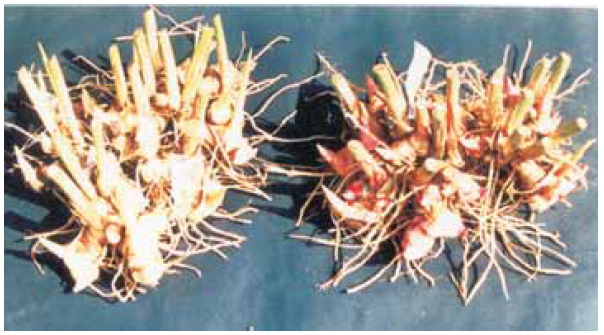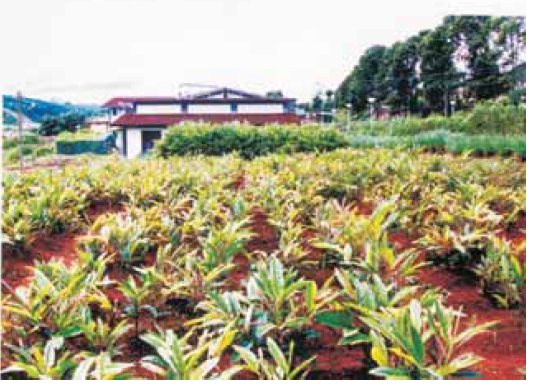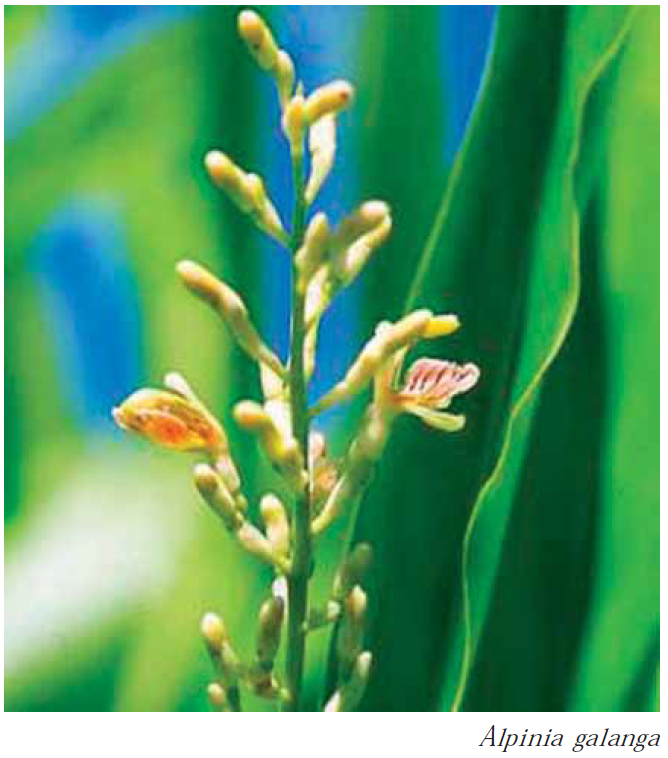Alpinia galanga
Alpinia galanga
Plant profile
| family | Zingiberaceae |
|---|---|
| Ayurvedic name | Kulanjana |
| Unani name | Khulanjan |
| Hindi name | Kulanjan, sugandha bach |
| Trade name | Kulanjan |
| Part used | Rhizome and seeds |
Therapeutic uses
The rhizome of kulanjan is carminative, aphrodisiac, febrifuge, and bronchodilator. It expels the phlegm (mucus), improves voice, and is very useful in sore throat and respiratory congestion. It is also used in rheumatism. The seeds have the same uses as the rhizome.
Morphological characteristics
The plant is a rhizomatous, perennial herb, and attains a height of about 1.5–2.5 m. The rhizome is very prominent and aromatic. Externally, it is reddish brown-white and internally reddish-white. Leaves are leathery, about 30–60 cm long and 10–15 cm, glossy on both surfaces, lanceolate and smooth, with white margins.
Floral characteristics
Flowers are greenish-white, about 3 cm long, and occur in dense panicles. Corolla has distinctly clawed lips. Flowering occurs in May and June, while fruiting occurs in August and September. Fruits are orange-red in colour.
Distribution
The species occurs naturally in shady and marshy lands in tropical areas, particularly in South India, and North-East India; elsewhere, it is cultivated.

Alpinia galanga-rhizomes
Climate and soil
The plant is successfully cultivated only on sandy loam soils and in humid tropical climate. It can be grown in open sunny areas with sufficient rainfall. With adequate irrigation provisions, it can be grown upto an altitude of 1000 m.
Varieties
No variety has been released so far. However, as per experiments, the accession no. IC-319683, available at NBPGR (National Bureau of Plant and Genetic Resources), Umiam (Meghalaya), has been found to give better yield.
Propagation material
Rhizome splits are used as planting material for commercial cultivation. Seed propagation is not feasible due to low germination rate.
Agro-technique
Nursery technique
- Raising propagules : Rhizome slices are directly planted in the field and no nursery stock is generally raised.
- Propagule rate and pretreatment : Planting rhizome slices @ 5.5 tonnes per hectare with a spacing of 30 cm × 30 cm for one-year crop and 3.5 tonnes per hectare with a spacing of 45 cm × 30 cm for two-year duration crop is recommended. No pretreatment is required before planting.
Planting in the field
- Land preparation and fertilizer application: The land is prepared by ploughing to achieve a fine tilth. FYM (farmyard manure) @ 5 tonnes is applied in the field at the time of land preparation. Besides, 150 kg of urea, 100 kg of muriate of potash, and 600 kg of single super phosphate are added as basal dose before planting. If required, lime @ 2 tonnes may also be applied in the field one month before planting to counter the acidic nature of soil. Well decomposed humus or vermicompost may also be used as manure instead of FYM.
- Transplanting and optimum spacing : February to mid-April is the best time for raising the crop in northeastern hilly tracts. Elsewhere, it could be planted in monsoon season. Whole or parts of rhizomes of approximately 50 g weight with 8–10 internodes are directly planted on hills in rows in the field. The rhizomes sprout in 15–20 days in the field. Optimum crop stand per hectare is 111 000 hills for one year crop at a spacing of 30 cm × 30 cm and 74 000 hills for two-year crop at a spacing of 45 cm × 45 cm.
- Interculture and maintenance practices : The total nitrogen requirement of the crop is about 300 kg, half of which is applied through urea at the time of planting. The rest of nitrogen (urea) should be applied in two equal split doses, that is, 75 kg; one at the time of first earthingup and the rest at the time of second earthing-up. Each urea application should always be followed by watering. Hoeing should be done twice, one at 45 days and another at 60 days after planting. Manual weedings should be done thrice at 60, 90, and 120 days after planting.
- Irrigation practices : The crop can be raised under rain-fed conditions on terraces in Meghalaya and other north-eastern states and elsewhere in India. Watering is done only during long dry spells.
- Disease and pest control : No significant pests and diseases have been observed on this crop except Colletotrichum spots, which can be controlled by spraying 1% Bordeaux mixture at monthly intervals after the appearance of leaf spots.

Alpinia galanga - a crop view
Harvest management
- Crop maturity and harvesting : Keeping in view the active chemical ingredients, the best time for harvesting of rhizome is last week of February when the crop becomes 12-month old. At this stage, the leaves turn pale or start drying. The rhizomes, thus harvested, contain 0.32% to 0.35% oil on dry weight basis. Generally, the crop can be harvested after either one or two years. But for preserving the germplasm, it can be kept as a perennial. In that case, frequent weeding, pegging, fertilizer application and related practices are to be carried out at regular intervals.
- Post-harvest management : After harvesting, the rhizomes should be cleaned, cut into slices, dried in the shade, and finally, stored in suitable containers in dry and cool places.
- Chemical constituents : The green rhizomes are reported to contain 0.04% essential (galangal) oil, which consists of methyl-cinnamate (48%), cineol (20%–30%), some camphor, and d-pinene. The dry rhizome has 0.12% (approximately) of oil, which is low in asarone.
- Yield and cost of cultivation : For a 12-month-old crop, yield of fresh rhizome is 23.93 tonnes per hectare, which on drying reduces to 5.65 tonnes per hectare. For 24-month-old crop, yield of fresh rhizomes is 82.91 tonnes per hectare, which gives 22.65 tonnes per hectare of dry rhizome.
Source: Agro-Techniques of selected medicinal plants
Last Modified : 7/1/2024
This topic provides information about the cultivat...
This topic provides information about cultivation ...
This topic provides information about cultivation ...
This content provides information on cultivation o...

